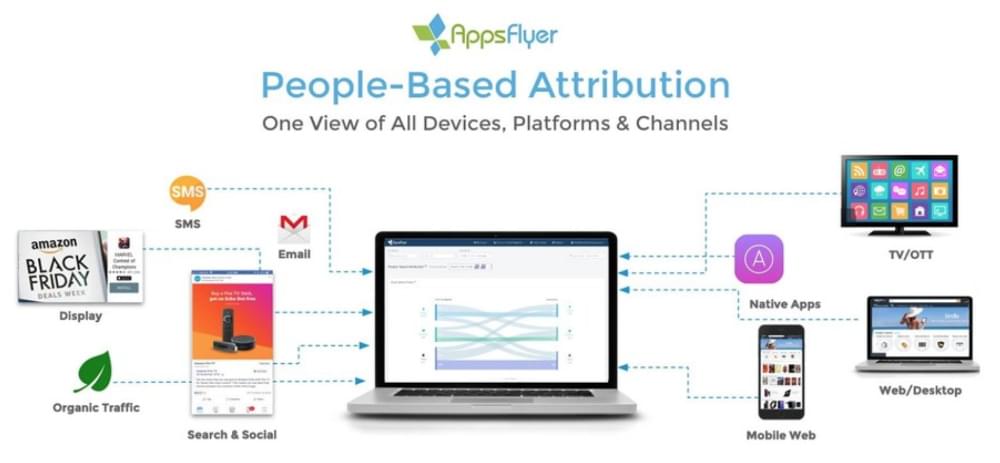This article was created in partnership with StudioWorks. Thank you for supporting the partners who make SitePoint possible.
Optimizing the user experience of your app is crucial for its success, and the best way to do so is by collecting data on how users interact with it. While regular analytic tools do a good job, there’s an even better way now.
Welcome to mobile attribution. This approach to measuring app performance allows you to discover where and how users are interacting with your app and connect them with key points in the app journey.
But what exactly is mobile attribution and how do you use it? Keep reading to learn.
Mobile Attribution Explained
Mobile attribution is the process of measuring two metrics, such as ad spend and app installs. Given that the mobile advertising industry will exceed $244 billion by 2020, you need to know which strategies and channels are wasting your money or generating the most returns.
Mobile attribution also helps mobile app developers and companies determine how users are interacting with apps and mobile ads. This information can then be used to optimize marketing campaigns, the user experience of an app, and more.
In a nutshell, the process looks like this:
 How mobile attribution works
How mobile attribution works
Not taking advantage of mobile attribution means that you won’t have the most detailed and accurate data on your mobile app and its advertising performance. This can result in missing opportunities when they arise, or discovering problems too late.
 Appsflyer is a market leader in ad attribution and analytics with their proprietary “People-based Attribution” technology
Appsflyer is a market leader in ad attribution and analytics with their proprietary “People-based Attribution” technology
Next, let’s talk more about why you should be using mobile attribution.
The Benefits of Mobile Attribution
These are some of the main benefits you will experience by taking advantage of mobile attribution.
Track user events to optimize your app
You will be able to track every little detail of how users interact with mobile ad campaigns in your app. This includes where they found your app originally, which pages they navigate to, and what features they interact with the most.
This information is priceless. It’s telling you exactly what pages and features users enjoy the most, which channels drive the most traffic, and what campaigns are generating the most results for your app.
You can then invest more capital into profitable channels, push favorite features to the forefront, and improve how every user engages with your application.
Reduce ad spend and improve campaign performance
Imagine being able to quickly discover which ad campaigns and channels are and aren’t driving results. You could cut the losers and invest more into the winners. That’s possible thanks to mobile attribution techniques.
Mobile attribution will present you with data on which advertisements, campaigns, and individual networks drive the most traffic, installs, and conversions to your app.
Many companies throw incredible amounts of money into poor performing campaigns and channels because they don’t have the data that mobile attribution can provide. Don’t be one of them.
How to Use Mobile Attribution
Mobile attribution is great and all, but how do you actually do it?
The first way is to use mobile app deep linking. This can be used to collect data on how users interact with your app. Deep linking is also capable of increasing installations and brand awareness.
Deep linking is available for both iOS and Android devices. By adding specific lines of code to a mobile app, developers are able to push users to the app store to download their app if they don’t have it and then forward them to the intended location.
 Mobile app deep linking example
Mobile app deep linking example
Deep links, as the name suggests, link to deeper features within an app versus the welcome screen. This saves users time and allows them to get to where they want to be faster.
You can follow the official Android and Apple documentation to learn how to add deep links into your app to begin reaping the benefits of mobile attribution.
Additionally, companies can invest in mobile attribution services. These give you all the tools and dashboards you need to collect deep analytics on your userbase and app.
Conclusion
Mobile attribution allows developers to bridge the gap between users and apps to collect critical information. This data can then be used to optimize the user experience, ads, and marketing campaigns.
You can start using mobile attribution today by enabling deep links within your or app or investing in attribution services that do most of the heavy lifting on your behalf.
What’s your experience so far with mobile attribution?
Frequently Asked Questions (FAQs) on Mobile Attribution
What is the importance of mobile attribution in digital marketing?
Mobile attribution plays a crucial role in digital marketing as it helps marketers understand the effectiveness of their marketing campaigns. It tracks user activities on mobile apps and websites, providing insights into which marketing channels or campaigns led to user engagement, conversions, or app installs. This data is invaluable for optimizing marketing strategies, allocating budgets, and improving overall ROI.
How does mobile attribution differ from web attribution?
While both mobile and web attribution aim to track user activities and determine the effectiveness of marketing campaigns, they differ in their tracking methods. Web attribution primarily uses cookies to track user activities, while mobile attribution relies on device IDs due to the limitations of cookies on mobile platforms. Additionally, mobile attribution also considers app installs, which is unique to mobile platforms.
What are the challenges in mobile attribution?
Mobile attribution comes with its own set of challenges. These include the fragmentation of mobile platforms and devices, the limitations of cookies on mobile, and the complexity of tracking user activities across multiple apps and websites. Additionally, privacy regulations and user opt-outs can also limit the data available for attribution.
How can I choose the right mobile attribution platform?
Choosing the right mobile attribution platform depends on your specific needs and goals. Some factors to consider include the platform’s tracking capabilities, integration with other marketing tools, data privacy compliance, reporting features, and customer support. It’s also important to consider the platform’s scalability and whether it can support your business as it grows.
What is the role of machine learning in mobile attribution?
Machine learning can greatly enhance mobile attribution by providing more accurate and predictive insights. It can analyze large amounts of data to identify patterns and trends, predict user behavior, and optimize marketing campaigns. Machine learning can also automate the attribution process, saving time and resources.
How does mobile attribution impact user privacy?
Mobile attribution involves collecting and analyzing user data, which raises concerns about user privacy. It’s important for businesses to comply with data privacy regulations, such as GDPR and CCPA, and to be transparent with users about how their data is being used. This includes obtaining user consent and providing options for users to opt-out.
Can mobile attribution help in retargeting campaigns?
Yes, mobile attribution can significantly improve retargeting campaigns. By tracking user activities and conversions, it can provide insights into which users are most likely to engage with your ads. This allows you to target your ads more effectively, improving engagement and conversion rates.
How does mobile attribution work with other marketing tools?
Mobile attribution platforms often integrate with other marketing tools, such as CRM systems, ad platforms, and analytics tools. This allows for a more holistic view of your marketing efforts and enables you to optimize your campaigns based on comprehensive data.
What is the future of mobile attribution?
The future of mobile attribution lies in advanced technologies like machine learning and AI, which can provide more accurate and predictive insights. As privacy regulations become stricter, there will also be a greater emphasis on privacy-preserving attribution methods. Additionally, as the mobile landscape continues to evolve, mobile attribution will need to adapt to new platforms and user behaviors.
How can I measure the success of my mobile attribution efforts?
The success of your mobile attribution efforts can be measured by the insights it provides and how these insights are used to optimize your marketing campaigns. Key metrics to consider include conversion rates, ROI, user engagement, and the effectiveness of different marketing channels. It’s also important to consider the accuracy of the attribution data and whether it’s helping you achieve your marketing goals.
 Dvora Goldstein
Dvora GoldsteinDvora is a freelance writer residing in Tel Aviv, Israel with 5 years of internet marketing experience. She frequently writes about SEO, Social media and all-things blogging. Learn more about Dvora on About.me.







